Anatomy Unit 2: Cells - Dr.Breslin - SWCTA 23-24
4.0(2)
Card Sorting
1/93
Earn XP
Description and Tags
Notes based off of the study guide for Dr.Breslins' second unit test about cells.
Study Analytics
Name | Mastery | Learn | Test | Matching | Spaced |
|---|
No study sessions yet.
94 Terms
1
New cards
3 main parts of the Animal Cell:
Nucleus, Cytoplasm (cytosol), Cell Membrane
2
New cards
What is cytology?
The study of cells
3
New cards
Cells vary in size, function, and structure. T/F?
True
4
New cards
All cells are born different. T/F?
False, all cells start out the same but eventually differentiate into specific types of cells.
5
New cards
Function of the cell membrane:
**AKA:** phospholipid bilayer - consists of phospholipids and embedded proteins. **Function:** membrane regulates what enters and leaves the cell. Selectively permeable.
6
New cards
What is the nucleus and its function?
“The brain of the cell” - directs cell activities and contains genetic information (dna) in the form of **chromatin**
* Nucleolus - responsible for the production of ribosomes
* RNA can exit the nucleus through the nuclear membrane
* Nucleolus - responsible for the production of ribosomes
* RNA can exit the nucleus through the nuclear membrane
7
New cards
What is cytoplasm?
Cytoplasm (AKA - cytosol) is the area between the nucleus and the membrane. A lot of cell metabolic reactions occur in this area.
8
New cards
What are the duties and functions of the endoplasmic reticulum?
**It is the transport system**. It has canals and channels that connect membranes to the nucleus and to organelles within the cell.
9
New cards
Smooth Endoplasmic Reticulum/ Smooth ER is for what:
lipid synthesis
10
New cards
Rough endoplasmic reticulum/ Rough ER does what:
It has ribosomes on the surface, so ribosomes make protein
11
New cards
What do ribosomes do?
Make protein
12
New cards
Function of the golgi apparatus:
Packages and delivers proteins produced by ribosomes, exported by vesicles
13
New cards
Mitochondria (AKA: powerhouse of the cell) function:
Transfers energy from food to a usable form called ATP, this process is called cellular respiration.
14
New cards
What does cellular respiration require:
It requires glucose (food) and oxygen, process done by mitochondria
15
New cards
What happens when the mitochondrial cannot produce enough ATP?
Cells lack energy to perform basic life processes (causing disease or other condition)
16
New cards
Function of lysosomes:
contain enzymes to break down substances: aka “suicide sack”
17
New cards
Effects of lysosome storage disorder:
Brain damage, jaundice, cataracts, enlarged liver, kidney damage, Tay Sachs: progressive deterioration of nerve cells and mental/physical abilities from 7 months-4 years old.
18
New cards
Function of centrosomes (aka: centrioles):
two cylinders; perpendicular, they form a spindle in cell division.
the spindle moves chromosomes during cell division so that each new cell gets the proper amount.
the spindle moves chromosomes during cell division so that each new cell gets the proper amount.
19
New cards
Function of cytoskeleton and what its made from:
made of microfilaments and microtubules, for cell shape and support. cilia and flagella are both involved in movement.
20
New cards
Why is the cell membrane important?
Without it, cells wouldn’t be able to bring in needed materials like food and oxygen, or remove waste. All of these occur at the cell membrane/phospholipid bilayer.
21
New cards
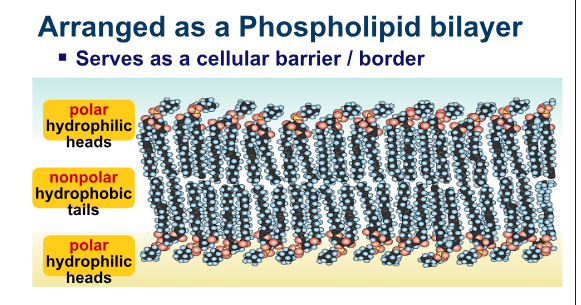
Structure of phospholipids:
* Phosphate head (hydrophilic - attracted to water - **polar)**
* Fatty acid tail (hydrophobic - repelled by water - **nonpolar**)
* Arranged as a bilayer, serves as a cellular barries/border
* Fatty acid tails/nonpolar hydrophobic tails are **impermeable to polar molecules**
* Fatty acid tail (hydrophobic - repelled by water - **nonpolar**)
* Arranged as a bilayer, serves as a cellular barries/border
* Fatty acid tails/nonpolar hydrophobic tails are **impermeable to polar molecules**
22
New cards
What does hydrophobic mean
Repelled by water
23
New cards
What does hydrophilic mean
Attracted to water
24
New cards
Why is increasing surface area important?
it can increase the cell’s efficiency of moving substances. **Villi** (digestive system cell projections) aid in absorbing nutrients with this.
25
New cards
What is passive transport?
a process where no energy is needed and it goes from high concentration to low concentration
Ex: Diffusion or Facilitated Diffusion (high to low)
Ex: Diffusion or Facilitated Diffusion (high to low)
26
New cards
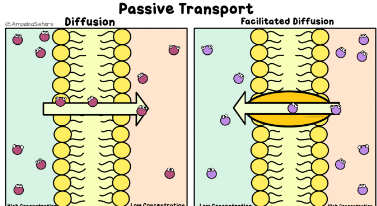
What is diffusion?
Molecules moving from **high-**concentration areas to **low-**concentration
* passive transport
* no energy needed
* passive transport
* no energy needed
27
New cards

What is facilitated diffusion?
Diffusion through __**protein channels**__
* **no energy needed**
* **passive transport**
* **high to low concentration**
* in __**PROTEIN CHANNELS**__
* **no energy needed**
* **passive transport**
* **high to low concentration**
* in __**PROTEIN CHANNELS**__
28
New cards
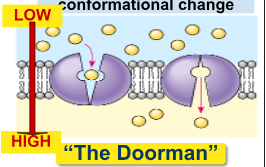
What is Active Transport?
When cells need to go **against (low -→ high) concentration gradient (high to low) they use Active transport.**
* **low to high**
* **protein “pump”**
* __**REQUIRES ENERGY = ATP**__
* **exocytosis and endocytosis**
* **low to high**
* **protein “pump”**
* __**REQUIRES ENERGY = ATP**__
* **exocytosis and endocytosis**
29
New cards

Is this a good example of what type of Diffusion: Facilitated, Diffusion, or Active Transport? (study this example)
Active Transport

30
New cards
What is **exocystosis?**
When things exit the cell: secretion
STUDY GUIDE ANSWER:
* Exocytosis - large particle leave the cell
STUDY GUIDE ANSWER:
* Exocytosis - large particle leave the cell
31
New cards
What is **endocytosis**?
* Phagocytosis - large solid things (ex: glucose)
* pinocytosis - bringing things in from the outside/liquid things (ex: water)
STUDY GUIDE ANSWER:
* Endocytosis- large particles enter the cell
* Pinocytosis- liquid enters the cell
* pinocytosis - bringing things in from the outside/liquid things (ex: water)
STUDY GUIDE ANSWER:
* Endocytosis- large particles enter the cell
* Pinocytosis- liquid enters the cell
32
New cards

Lable and study each type of transport - click for labeled answer
Study!
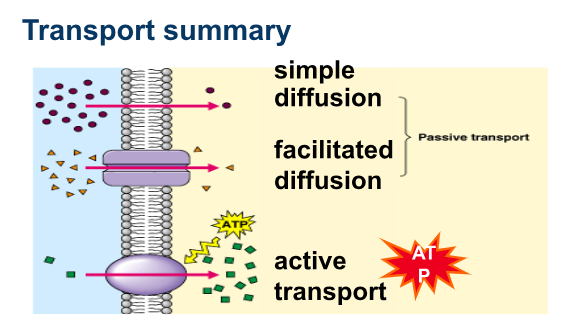
33
New cards
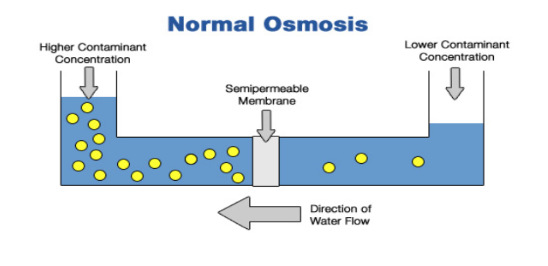
What is osmosis?
The diffusion/movement of water
34
New cards
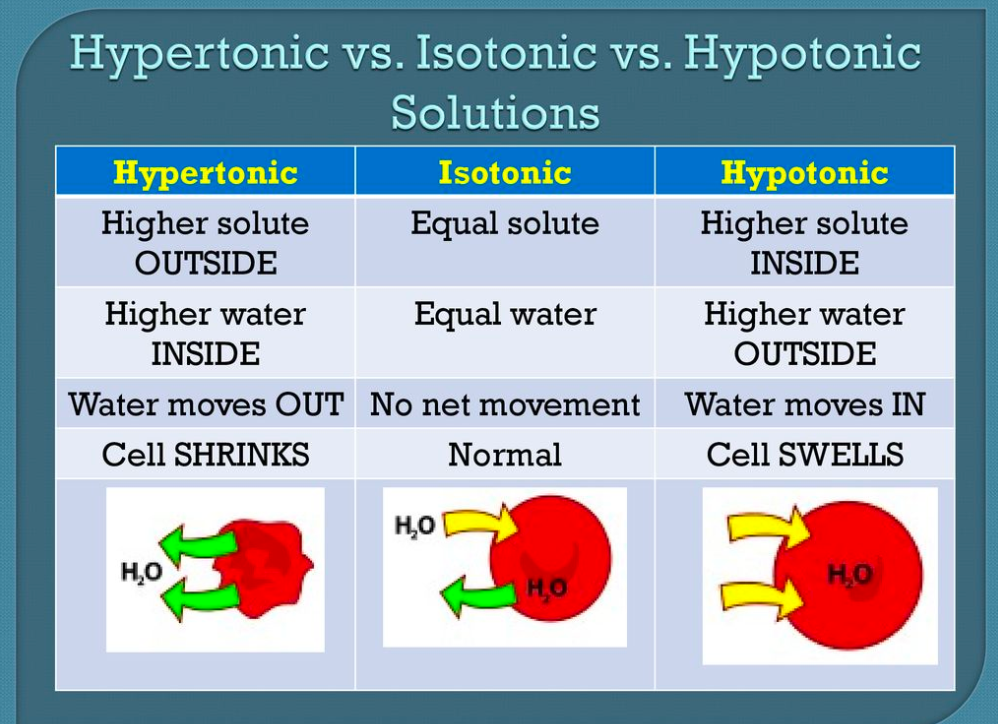
Study to predict the movement of water based on the solution (hypertonic, hypotonic, or isotonic)
NEED TO KNOW THESE!!!!
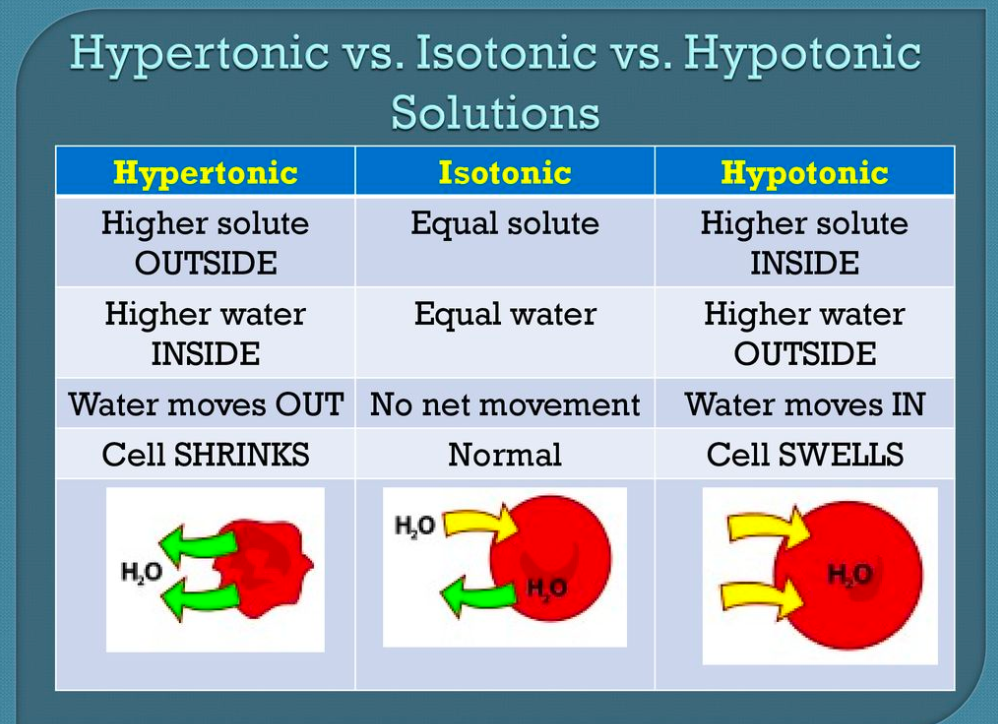
35
New cards
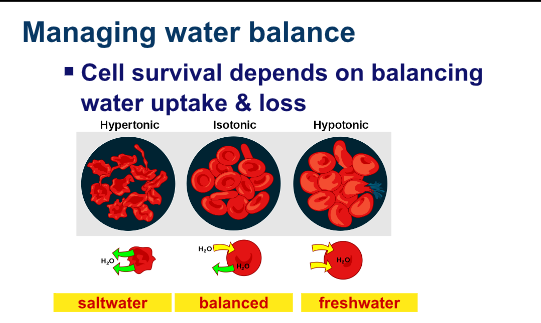
Hypotonic cells have:
* high water, low solute
* freshwater
* cell gains water
* cell swells, then explodes and bursts
* “KABOOM!”
* freshwater
* cell gains water
* cell swells, then explodes and bursts
* “KABOOM!”
36
New cards
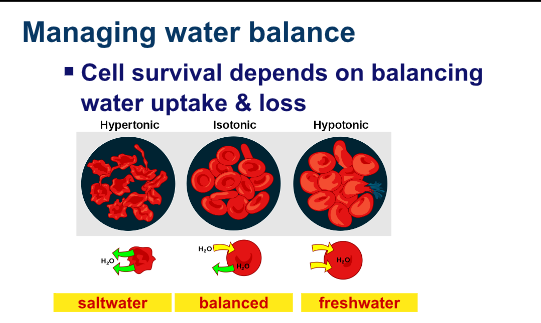
Hypertonic cells have:
* low water, high solute
* salt water
* cell dehydrated and dries out
* then dies from no water
* “im shrinking, i’m shriveled!”
* salt water
* cell dehydrated and dries out
* then dies from no water
* “im shrinking, i’m shriveled!”
37
New cards
Isotonic cells have:
* mild salt solution
* equal solute and equal water concentration
* no problems
* no net movement, equal flow
* cell is balanced
* cell is stable
* “im perfect!”
* equal solute and equal water concentration
* no problems
* no net movement, equal flow
* cell is balanced
* cell is stable
* “im perfect!”
38
New cards
Why should we study carbon?
All of life is built on carbon!
39
New cards
How many bonds does carbon form?
They can form 4 stable covalent bonds and can form carbohydrates, lipids, proteins, nucleic acids too!
* These cells are usually 72% H2O and 25% Carbon compounds
* **(??? not too sure about this question)**
* These cells are usually 72% H2O and 25% Carbon compounds
* **(??? not too sure about this question)**
40
New cards
What are macromolecules?
Smaller organic molecules joining together to form larger molecules
4 major classes:
* carbohydrates
* lipids
* proteins
* nucleic acids
4 major classes:
* carbohydrates
* lipids
* proteins
* nucleic acids
41
New cards
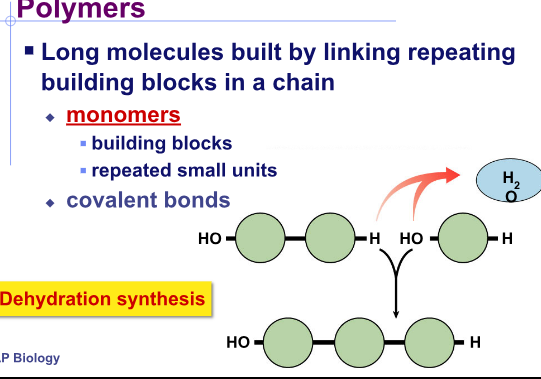
What are polymers?
Long molecules are built by linking repeating building blocks in a chain
* Dehydration synthesis - adding energy, removing the water
* Dehydration synthesis - adding energy, removing the water
42
New cards

How do you build a polymer?
Usin**g dehydration synthesis** - you join monomers by “taking H2O out”
* This requires energy and enzymes, takes out the water
* **adds energy, removes the water**
* This requires energy and enzymes, takes out the water
* **adds energy, removes the water**
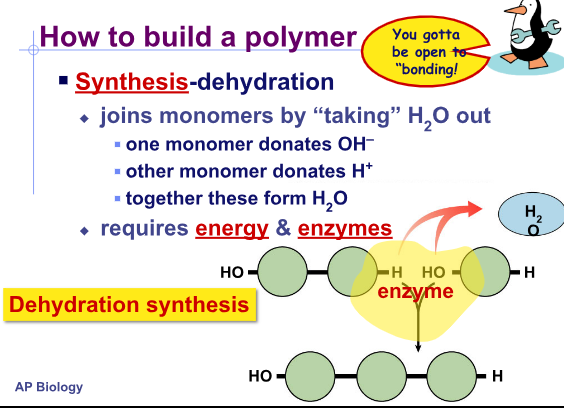
43
New cards
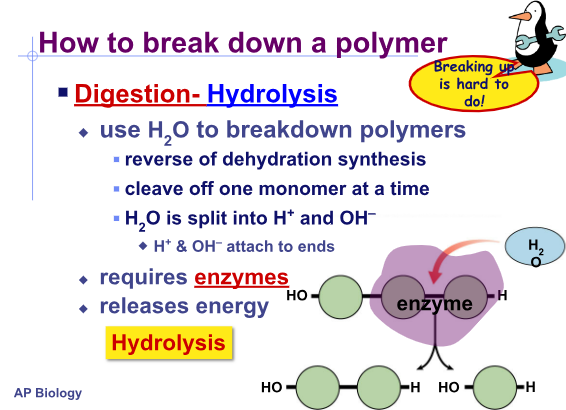
How do you break down a polymer?
Digestion: Hydrolysis
* use water/H2O to breakdown the polymer
* uses energy and enzymes
* adds water, releases energy
* use water/H2O to breakdown the polymer
* uses energy and enzymes
* adds water, releases energy
44
New cards
Monomer of carbohydrates:
Monosaccharides (C:H:O | 1:2:1)
45
New cards
Monomer of proteins:
Amino acids (CHON, -COOH, -NH2)
46
New cards
Monomer of lipids:
glycerol/fatty acids (C:H:O | greater than 2:1 H:O \[carboxyl group\])
47
New cards
Monomers of DNA/nucleic acids:
nucleotides (CHONP pentose, nitrogenous base, phosphate)
48
New cards
What are the functions of nucleic acids:
they store information (like genes and blueprints for building proteins, dna→ rna → protein), gather genetic material, and transfer information for the next generations of new cells
49
New cards
What is RNA
RNA is a ribo-nucleic acid, single helix in shape
50
New cards
Are monomers nucleotides? T/F
True
51
New cards
What is DNA?
DNA is deoxyribonucleic acid, double helix in shape
52
New cards
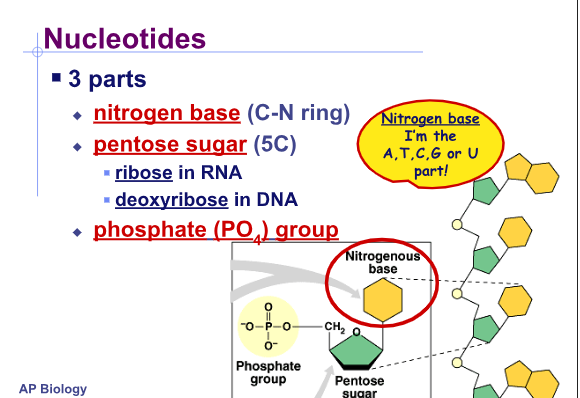
Nucleotide Parts (3):
* Nitrogen base - (C-N ring) (a,t,c,g,u part)
* Pentose sugar (5C) - ribose in RNA and deoxyribose in DNA
* Phosphate (PO4) group
* Pentose sugar (5C) - ribose in RNA and deoxyribose in DNA
* Phosphate (PO4) group
53
New cards
What are purines and list the two examples:
* Purines have a double ring N base
* Adenine (A) and Guanine (G)
* Adenine (A) and Guanine (G)
54
New cards
What are pyrimidlines and list the three examples:
* Pyrimidlines are single ring N bases
* Cytosine (C) and Thymine (T) and Uracil (U)
* Cytosine (C) and Thymine (T) and Uracil (U)
55
New cards
Purine :: Pyrimidline | What goes with what? (A,G,C,T)
A::T (2 H bonds)
G:: C (3 H bonds)
G:: C (3 H bonds)
56
New cards
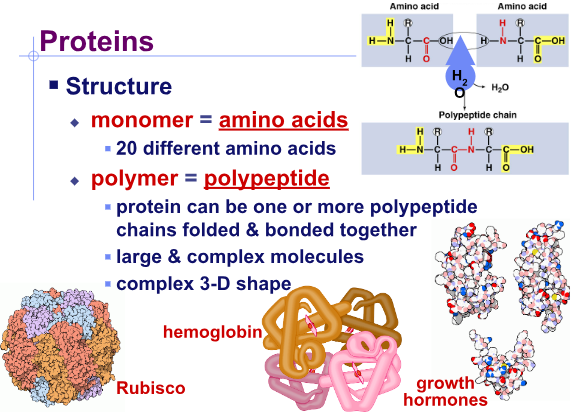
Structure of proteins:
* 20 different amino acids/monomers
* polypeptide/polymers, large and complex molecules, complex 3-D shape
* polypeptide/polymers, large and complex molecules, complex 3-D shape
57
New cards

Function of proteins:
* literally almost everything
* study list
* know they are the most structurally and functionally diverse
* study list
* know they are the most structurally and functionally diverse
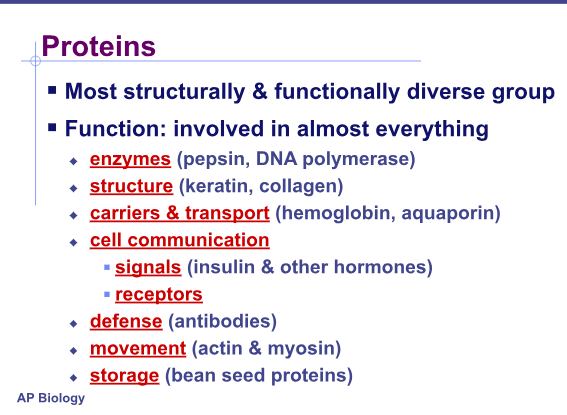
58
New cards
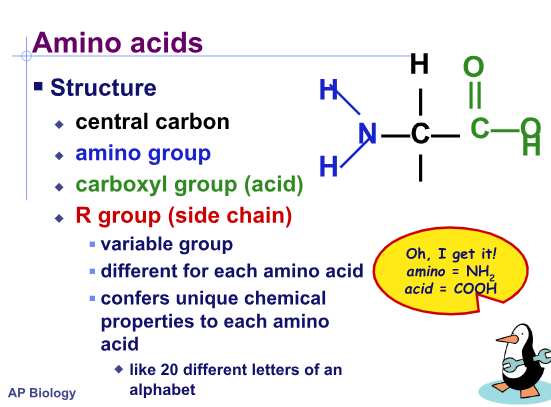
structure of amino acids:
* central carbon
* amino group
* carboxyl group (acid)
* R group (side chain) (1 of the 20)
* amino group
* carboxyl group (acid)
* R group (side chain) (1 of the 20)
59
New cards
Protein: List the 4 levels of folding and their functions
* Primary structure (1)- order of amino acids in chain, sequence determined by DNA/gene, slight change can change function and structure!!
* Secondary structure (2)- local folding, short sections of polypeptides, H bonds, alpha helix or beta pleated sheets (3-D structures in sections)
* Tertiary structure (3)- whole protein/molecule folding, hydrophobic, h bonds and ionic bonds, disulfide bridges
* Quaternary structure (4)- not all proteins, only ones with multiple polypeptide chains, hydrophobix interactions
* Secondary structure (2)- local folding, short sections of polypeptides, H bonds, alpha helix or beta pleated sheets (3-D structures in sections)
* Tertiary structure (3)- whole protein/molecule folding, hydrophobic, h bonds and ionic bonds, disulfide bridges
* Quaternary structure (4)- not all proteins, only ones with multiple polypeptide chains, hydrophobix interactions
60
New cards
What happens when you unfold a protein? (protein denaturation)
* temperature, pH, and salinity can disrupt H, ionic bonds, or disulfide bridges
* in 2 and 3 structure it alters their shape
* denaturation destroys functionality, some proteins can return to their functional shape, others cannot
* in 2 and 3 structure it alters their shape
* denaturation destroys functionality, some proteins can return to their functional shape, others cannot
61
New cards
What makes a carbohydrate..a carbohydrate?
any molecule that has the elements C:H:O in a 1:2:1 ratio.
62
New cards
Simple vs complex carbohydrates:
* simple: made up of one or two monomers
* complex: long polymers (aka: polysaccharides, good fo r storing energy)
* complex: long polymers (aka: polysaccharides, good fo r storing energy)
63
New cards
Monosaccharides consist of:
one monomer subunit (ex: sugar glucose: C6H12C6
64
New cards
disaccharides consist of:
two monosaccharides: ex: sugar sucrose/table sugar - glucose +fructose= sucrose
65
New cards
Plants form what?
starch
66
New cards
Animals form what?
glycogen
67
New cards
Where is cellulose found in plants?
their cell walls
68
New cards
Where is chitin found in many invertebrates and cell walls of fungi?
in the exoskeletons
69
New cards
Function of lipids:
* long term energy storage
* concentrated energy
* cushions organs
* insulates body
* concentrated energy
* cushions organs
* insulates body
70
New cards
Lipids make polymers T/F?
F - false, they do not form polymers. Big molecules make smaller subunits, not a continuing chain.
71
New cards
Structure of lipids/fats:
glycerol + a fatty acid
* the fatty acid = the long HC “tail” with COOH (carboxyl group) “head”
* can be seen in dehydration synthesis
* the fatty acid = the long HC “tail” with COOH (carboxyl group) “head”
* can be seen in dehydration synthesis
72
New cards
Is the long HC chain of lipids/fats Polar/non-polar and hydrophilic/hydrophobic?
* non-polar
* hydrophobic
* hydrophobic
73
New cards
Triaglycerol has:
* 3 fatty acids linked to glycerol
* ester linkage - between OH and COOH
* ester linkage - between OH and COOH
74
New cards
Cholesterol is a four ring structure? T/F
T - helps keep cell membranes fluid and flexible
* its in the animal cell membranes and a precursor of **all the other steroids**
* high levels of cholesterol in blood may contribute to cardiovascular disease
* its in the animal cell membranes and a precursor of **all the other steroids**
* high levels of cholesterol in blood may contribute to cardiovascular disease
75
New cards
Function of cholesterol:
* keeps cell membranes fluid and flexible
* precursor for steroids
* important component of cell membrane
* precursor for steroids
* important component of cell membrane
76
New cards
Structure of steroids:
* 4 fused C rings + (x)
* x can be any functional group
* steroids are formed from cholesterol
* different functional groups → different cellular functions
* x can be any functional group
* steroids are formed from cholesterol
* different functional groups → different cellular functions
77
New cards
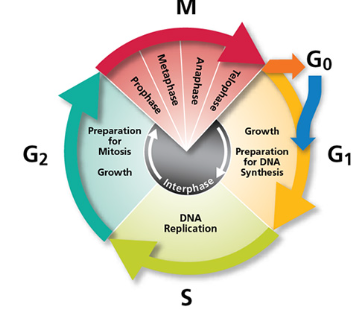
List the stages of a cells life cycle:
* Interphase = growth phase (G1, S, G2)
* Mitosis = nuclear division
* Cytokinesis (cell division)
* study diagram
* Mitosis = nuclear division
* Cytokinesis (cell division)
* study diagram
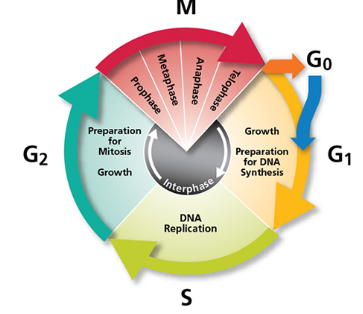
78
New cards
What happens in interphase? (G1, G0, S, G2)
* G0 - non-dividing phase, growth
* G1 - growth phase 1, preparation for DNA Synthesis
* S - DNA replication: DNA must be copied and replicated ensuring the new cells contain the proper amount of dna
* G2 - Preparation for Mitosis, growth
* G1 - growth phase 1, preparation for DNA Synthesis
* S - DNA replication: DNA must be copied and replicated ensuring the new cells contain the proper amount of dna
* G2 - Preparation for Mitosis, growth
79
New cards
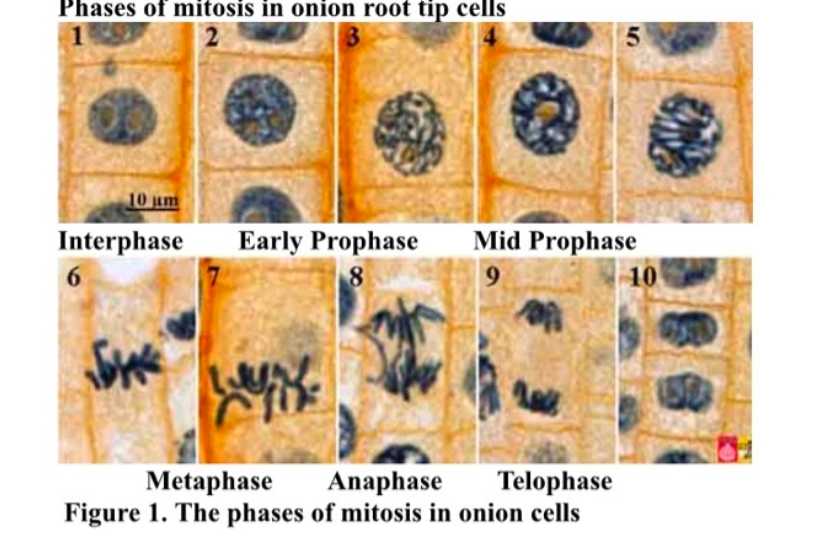
Be able to recognize parts of PMAT in the onion root:
Study! You don’t have to know pre- and mid- just know what the phases look like

80
New cards
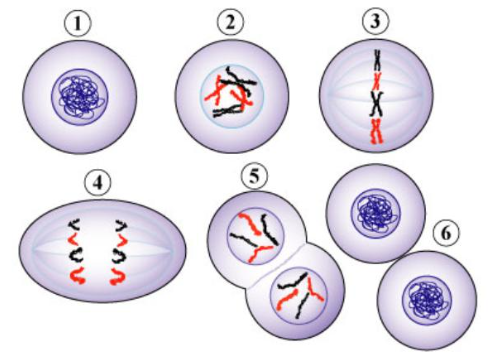
What does PMAT stand for? What are the stages of Mitosis?
* PMAT - prophase, metaphase, anaphase, telophase
* Mitosis - Interphase (1), Prophase (2), Metaphase(3), Anaphase (4), Telophase(5), (Cytokinesis (6))
* Mitosis - Interphase (1), Prophase (2), Metaphase(3), Anaphase (4), Telophase(5), (Cytokinesis (6))

81
New cards
What happens in Cytokinesis?
* Division of the cytoplasm happens to form 2 new daughter cells
* organelles are divided
* daughter cells are genetically identical
* then cells return to interphase to keep replicating!
* organelles are divided
* daughter cells are genetically identical
* then cells return to interphase to keep replicating!
82
New cards
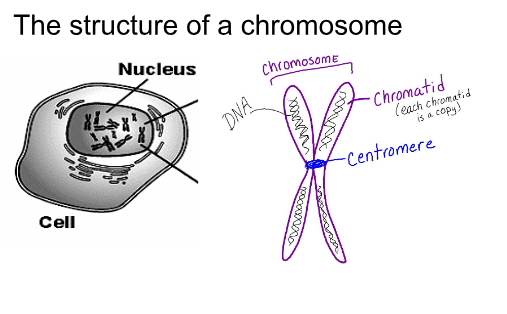
Chromatins vs Chromosomes
Chromosomes are made up of a DNA-protein complex called chromatin - study diagram for parts
83
New cards
What happens in prophase?
* visible chromosomes (aka - chromatids)
* centrioles migrate to the poles
* nuclear membrane disappears
* nucleolus disappears
* spindle forms
* centrioles migrate to the poles
* nuclear membrane disappears
* nucleolus disappears
* spindle forms
84
New cards
85
New cards
What happens in metaphase?
* chromosomes line up on the equator
* and the spindle attatches
* and the spindle attatches
86
New cards
What happens in Anaphase?
* chromatids seperate at the centromere and move to opposite poles
* think of A for anna in frozen being pulled away bc of her sister elsa
* think of A for anna in frozen being pulled away bc of her sister elsa
87
New cards
What happens in Telophase?
* chromosomes disappear - chromatin
* nuclear membrane reforms
* nucleoli reappears
* spindle disappears
* centrioles duplicate
* nuclear membrane reforms
* nucleoli reappears
* spindle disappears
* centrioles duplicate
88
New cards
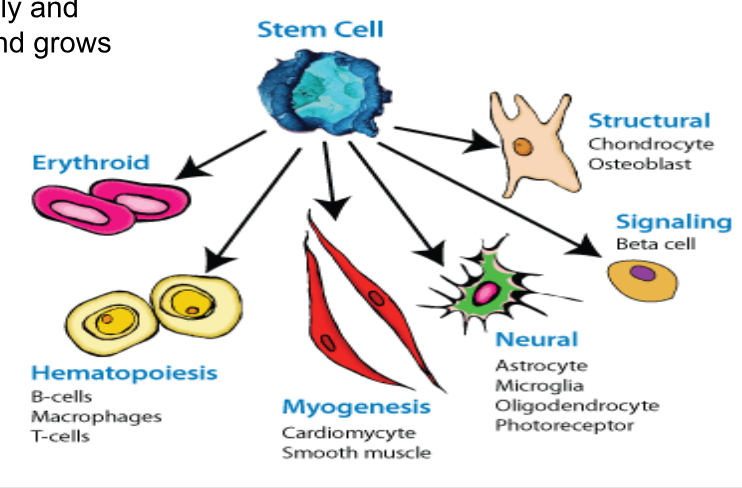
When does differentiation occur?
As cells multiply and organisms develop and grow
Stem cell → then to whatever is needed in the organism
* stem cells can be many different types of cells, each with their own distinct function
Stem cell → then to whatever is needed in the organism
* stem cells can be many different types of cells, each with their own distinct function
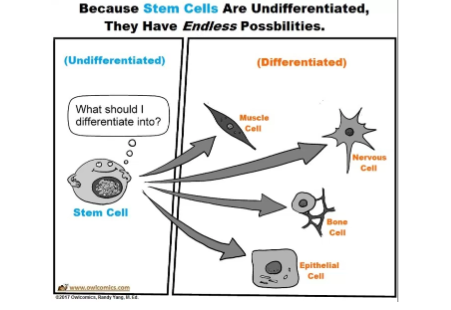
89
New cards
How is cancer caused?
By uncontrolled cell division. In normal cells, cell division eventually stops. With cancer cells, their DNA is damaged and never had division stop.
90
New cards
How are chromosomes inherited?
1 from mom, one from dad
91
New cards
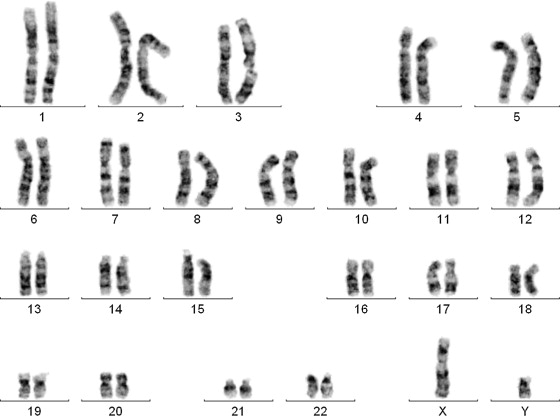
There are 23 pairs of human chromosomes T/F?
True
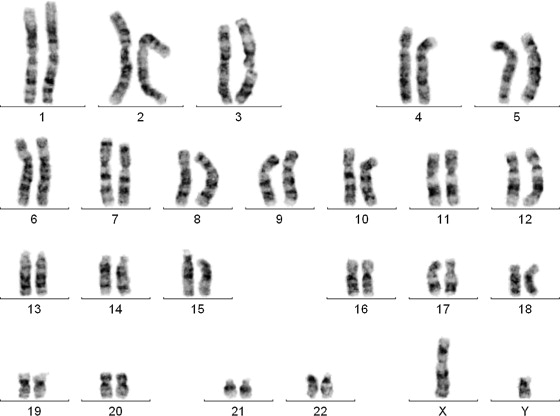
92
New cards
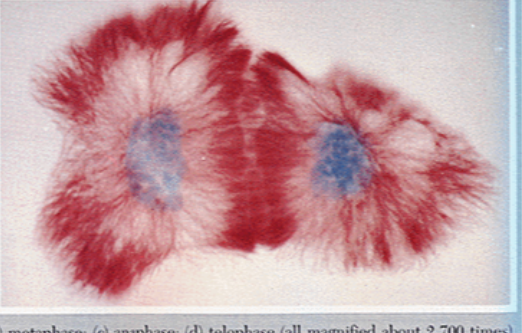
What phase of MPAT is this?
Telophase
93
New cards
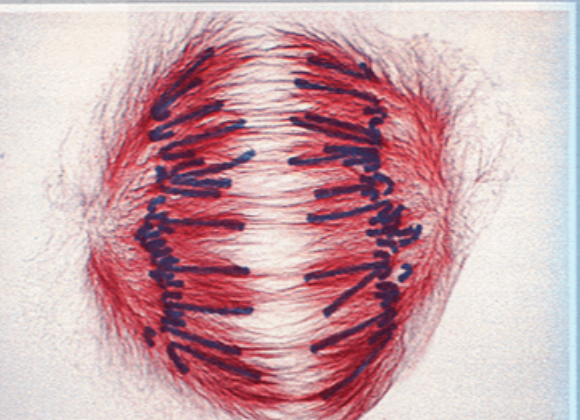
What phase of MPAT is this?
Anaphase
94
New cards
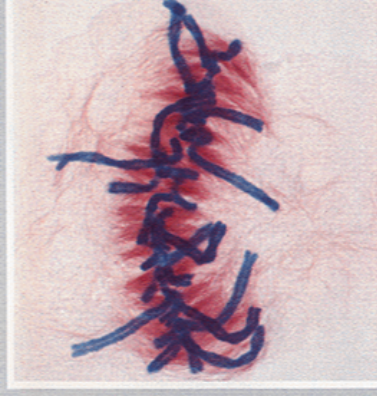
What phase of MPAT is this?
Metaphase